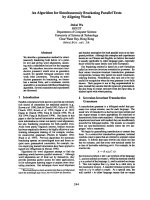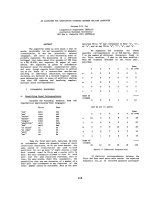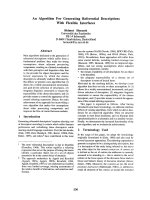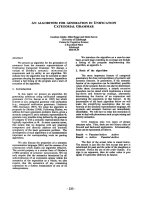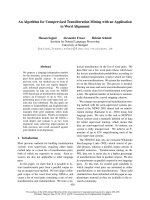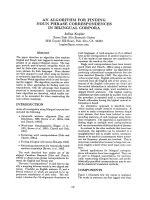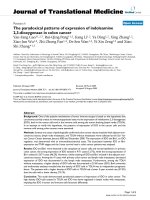Báo cáo hóa học: "ITERATIVE ALGORITHM FOR SOLVING MIXED QUASI-VARIATIONAL-LIKE INEQUALITIES WITH SKEW-SYMMETRIC TERMS IN BANACH SPACES" doc
Bạn đang xem bản rút gọn của tài liệu. Xem và tải ngay bản đầy đủ của tài liệu tại đây (567.38 KB, 16 trang )
ITERATIVE ALGORITHM FOR SOLVING MIXED
QUASI-VARIATIONAL-LIKE INEQUALITIES WITH
SKEW-SYMMETRIC TERMS IN BANACH SPACES
LU-CHUAN CENG, QAMRUL HASAN ANSARI, AND JEN-CHIH YAO
Received 1 April 2006; Accepted 28 May 2006
We develop an iterative algorithm for computing the approximate solutions of mixed
quasi-variational-like inequality problems with skew-symmetric terms in the setting of
reflexive Banach spaces. We use Fan-KKM lemma and concept of η-cocoercivity of a com-
position mapping to prove the existence and convergence of approximate solutions to the
exact solution of mixed quasi-variational-like inequalities with skew-symmetric terms.
Furthermore, we derive the posteriori error estimates for approximate solutions under
quite mild conditions.
Copyright © 2006 Lu-Chuan Ceng et al. This is an open access article distributed under
the Creative Commons Attribution License, which permits unrestricted use, distribution,
and reproduction in any medium, provided the original work is properly cited.
1. Introduction
It is well known that variational inequality theory, as a very effective and powerful tool,
not only has stimulated new results dealing with part ial differential equations, but also
has been applied to a large variety of problems arising in mechanics, contact problems in
elasticity, optimization and control problems, management science, operations research,
general equilibrium problems in economics and transportation, unilateral problems, ob-
stacle problems, and so forth. Because of its wide applications, the classical variational
inequality has been studied and generalized in various directions previously by many
authors. Among these generalizations, mixed variational-like inequality problem is of in-
terest and impor tance. One of the most important and interesting problems in the theory
of variational i nequality is the development of an efficient and implementable algorithm
for solving variational inequality and its generalizations. These methods include projec-
tion method and its variant forms, linear approximation, descent and Newton’s methods,
and method based on the auxiliary principle technique. The method based on auxil-
iary pr inciple technique was first suggested by Glowinski et al. [6] for solving variational
inequalities in 1981. Subsequently, it has been used to solve a number of gener alizations
Hindawi Publishing Corporation
Journal of Inequalities and Applications
Volume 2006, Article ID 82695, Pages 1–16
DOI 10.1155/JIA/2006/82695
2 Iterative algorithm for solving MQVLIP
of classical variational inequalities; see, for example, [1, 4, 8, 14–16] and the references
therein.
Let H be a real Hilbert space whose inner product and norm are denoted by
·,·,
and
·, respectively. Let D be a nonempty convex subset of H.LetT, A : D → H,and
η : D
× D → H be mappings, and let f : D → R be a real-valued function. Recently, Ansari
and Yao [1] (see also [10]) considered and studied the mixed var iational-like inequality
problem (MVLIP), which is to find u
∗
∈ D such that
Tu
∗
− Au
∗
,η
v,u
∗
+ f (v) − f
u
∗
≥
0, ∀v ∈ D. (1.1)
When A
≡ 0, this problem reduces to the following problem considered by Dien [3], Noor
[11] and Siddiqi et al. [12]: find u
∗
∈ D such that
Tu
∗
,η
v,u
∗
+ f (v) − f
u
∗
≥
0, ∀v ∈ D. (1.2)
In [1], Ansari and Yao introduced the concepts of η-cocoercivity, η-strong monotonic-
ity, and η-strong convexity of a mapping, which generalize the definitions of cocoercivity
[13, 17], strong monotonicity [9], and strong convexity [9], respectively. It is easy to see
that η-cocoercivity is an intermediate concept that lies between η-strong monotonicity
and η-monotonicity. They applied the auxiliary variational inequality technique to sug-
gest an iterative algorithm for finding the approximate solutions of MVLIP and proved
that these approximate solutions converge to the exact solution of MVLIP.
Motivated and inspired by the work in [1], we consider and study a class of mixed
quasi-variational-like inequality problems in the setting of Banach spaces.
Let D be a nonempty convex subset of a real Banach space B,letB
∗
be the topological
dual space of B,andlet
u,v be the duality pairing between u ∈ B
∗
and v ∈ B.LetT,
A : D
→ B
∗
, N : B
∗
× B
∗
→ B
∗
,andη : D × D → B be mappings and w
∗
∈ B
∗
.Letϕ : B ×
B → R
{+∞} be a real bifunction. The mixed quasi-variational-like inequality problem
(MQVLIP) is to find u
∈ D such that
N(Tu,Au) − w
∗
,η(v,u)
+ ϕ(v, u) − ϕ(u,u) ≥ 0, ∀v ∈ D. (1.3)
This problem was first introduced and studied by Ding and Yao [4]. They applied the
auxiliary variational inequality technique to suggest an iterative algorithm for computing
the approximate solutions of MQVLIP (1.3), and provided the convergence criteria of
approximate solutions to the exact solution of MQVLIP (1.3).
In this paper, we propose a new iterative algorithm for computing the approximate
solutions of MQVLIP (1.3) with skew-symmetric term ϕ(
·,·) in the setting of a reflex-
ive Banach space B. Our proposed iterative algorithm can be seen as an extension and
generalization of Ansari and Yao’s [1] iterative algorithm. We employ Fan-KKM lemma
and concept of η-cocoerciv ity of a composition mapping to prove the existence and con-
vergence of approximate solutions to the exact solution of MQVLIP (1.3)withskew-
symmetric term ϕ(
·,·). Compared with Ansari and Yao [1, Theorem 3.2], our results
improve and gener a lize their Theorem 3.2 in the following aspects: (i) the MQVLIP (1.3)
is more general than MVLIP considered by them; (ii) we remove boundedness assump-
tion on D; (iii) our convergence criteria for approximate solutions are very different from
Lu-Chuan Ceng et al. 3
their ones because of the appearance of skew-symmetric term ϕ(
·,·)inMQVLIP(1.3);
(iv) the technique of our proof is very different from the one of their proof since reflexive
Banach space is more general than Hilbert space; (v) we provide the poster iori error es-
timates for approximate solutions under quite mild conditions. Hence the results of this
paper also extend and generalize the results of Zhu and Marcotte [17].
2. Preliminaries
In this section we will recall the following definitions and some known results.
Definit ion 2.1. Let D be a nonempty subset of a Banach space B with the dual space B
∗
.
Let T : D
→ B
∗
and η : D × D → B be two mappings. Then,
(i) T is cal led η-monotone,if
Tu− Tv, η(u,v)
≥
0, ∀u,v ∈ D; (2.1)
(ii) T is cal led η-strongly monotone, if there exists a constant β>0, such that
Tu− Tv, η(u,v)
≥
βu − v
2
, ∀u,v ∈ D; (2.2)
(iii) T is cal led η-cocoercive, if there exists a constant ξ>0, such that
Tu− Tv, η(u,v)
≥
ξTu− Tv
2
, ∀u,v ∈ D; (2.3)
(iv) T is called η-relaxed monotone, if there exists a constant ξ>0, such that
Tu− Tv, η(u,v)
≥
βu − v
2
, ∀u,v ∈ D; (2.4)
(v) T is cal led Lipschitz continuous, if there exists a constant L>0, such that
Tu− Tv≤Lu − v, ∀u,v ∈ D; (2.5)
(vi) η is called Lipschitz continuous, if there exists a constant δ>0, such that
η(u,v)
≤
δu − v, ∀u,v ∈ D. (2.6)
We illustrate hereafter the relationships among η-monotonicity, η-strong monotonic-
ity, η-cocoercivity, and Lipschitz continuity as follows:
(i) η-strong monotonicity
=⇒ η-monotonicity ⇐= η-cocoercivity;
(ii)
T is η-strong monotone
T is Lipschitz continuous
=⇒ T is η-cocoercive; (2.7)
(iii)
T is η-cocoercive
η is Lipschitz continuous
=⇒ T is Lipschitz continuous. (2.8)
4 Iterative algorithm for solving MQVLIP
Definit ion 2.2. The bifunction ϕ : B
× B → R
{+∞} is said to be skew-symme tric if
ϕ(u,u)
− ϕ(u,v) − ϕ(v,u)+ϕ(v,v) ≥ 0, ∀u,v ∈ B. (2.9)
The skew-symmetric bifunctions have properties which can be considered analogs of
monotonicity of gradient and nonnegativity of a second derivative for convex functions.
For properties and applications of skew-symmetric bifunction, reader may consult [2].
Definit ion 2.3. Let D beaconvexsubsetofaBanachspaceB and let K : D
→ R be a
Fr
´
echet differentiable function. K is said to be
(i) η-convex [7], if
K(v)
− K(u) ≥
K
(u),η(v,u)
, ∀u,v ∈ D; (2.10)
(ii) η-strongly convex [11], if there exists a constant μ>0, such that
K(v)
− K(u) −
K
(u),η(v,u)
≥
μ
2
u − v
2
, ∀u,v ∈ D. (2.11)
In particular, if η(v,u)
= v − u for all v,u ∈ D,thenK is said to be strongly convex.
Proposition 2.4. Let K be a differentiable η-strong ly convex functional with constant μ>0
on a convex subset D of B,andletη : D
× D → B be a mapping such that η(u,v)+η(v,u) = 0,
for all u,v
∈ D. Then K
is η-strongly monotone with constant μ>0.
Proof. Since K is η-strongly convex, we deduce that for each u,v
∈ D
K(v)
− K(u) −
K
(u),η(v,u)
≥
μ
2
u − v
2
,
K(u)
− K(v) −
K
(v),η(u,v)
≥
μ
2
v − u
2
.
(2.12)
Adding these two inequalities and using the condition that η(u,v)+η(v,u)
= 0, we obtain
K
(v) − K
(u),η(v,u)
≥
μv − u
2
. (2.13)
A function F : D → R is called weakly sequentially continuous at x
0
∈ D,ifF(x
k
) →
F(x
0
)(n →∞)foreachsequence{x
k
}⊂D con v erging weakly to x
0
. F is called weakly
sequentially continuous on D, if it is weakly sequentially continuous at each point of D.
Lemma 2.5. Let η(v,
·):D → B and K
be s e quentially continuous from the weak topology
to the weak topology and from the weak topology to the strong topology, respectively, where v
is any fixed point in D. Then the function g : D
→ R,definedasg(u) =K
(u),η(v,u) for
each fixed v
∈ D, is weakly sequentially continuous on D.
Lu-Chuan Ceng et al. 5
Proof. Let u be any given point in D,andlet
{u
n
}⊂D be any sequence converging weakly
to u.Then,
K
(u
n
) − K
(u)→0(n →∞), and {η(v,u
n
)} converges weakly to η(v,u)for
each fixed v
∈ D.Observethat
g
u
n
−
g(u)
=
K
u
n
−
K
(u),η
v,u
n
+
K
(u),η
v,u
n
−
η(v,u)
≤
K
u
n
−
K
(u)
η
v,u
n
+
K
(u),η
v,u
n
−
η(v,u)
−→
0asn −→ ∞ .
(2.14)
Therefore, the conclusion immediately follows.
For each D ⊂ B, we denote by co(D)theconvexhullofD. A point-to-set mapping
G : D
→ 2
B
is called a KKM mapping if, for every finite subset {u
1
,u
2
, ,u
k
} of D,
co
u
1
,u
2
, ,u
k
⊂
k
i=1
G
x
i
. (2.15)
In the next section, we will use the following result.
Lemma 2.6 (Fan-KKM [5]). Let D be an arbitrary nonempty s ubset in a topological vector
space E,andletG : D
→ 2
E
be a KKM mapping. If G(u) is closed for all u ∈ D andiscompact
foratleastoneu
∈ D, then
u∈D
G(u) =∅.
3. Iterative algorithm and its convergence
In this section, following the approach of Ansari and Yao [1], we will apply the auxiliary
variational inequality technique to suggest a general algorithm for finding approximate
solutions of MQVLIP (1.3) w ith skew-symmetric term ϕ(
·,·). Moreover, we will also
study convergence analysis of proposed algorithm.
Algorithm 3.1. Let K : D
→ R be a given Fr
´
echet differentiable functional, let {ρ
n
}
∞
n=0
be a
sequence of positive parameters, and let u
0
be any initial guess in D. For each given iterate
u
n
∈ D, consider the following auxiliary variational inequality problem: find u
n+1
∈ D,
such that
ρ
n
N
Tu
n
,Au
n
−
ρ
n
w
∗
+ K
u
n+1
−
K
u
n
,η
v,u
n+1
+ ρ
n
ϕ
v,u
n+1
−
ρ
n
ϕ
u
n+1
,u
n+1
≥
0, ∀v ∈ D,
(3.1)
where K
(u)istheFr
´
echet derivative of a function K : D → R at u ∈ D.
Theorem 3.2. Let D be a nonempty closed convex subset of a reflexive Banach space B with
the dual space B
∗
.LetT, A : D → B
∗
, N : B
∗
× B
∗
→ B
∗
,andη : D × D → B be mappings.
Let w
∗
∈ B
∗
and ϕ : B × B → R
{+∞} be skew-symmetric and weakly continuous, such
that for each v
∈ B, int(domϕ(·,v)) ∩ D =∅and ϕ(·, v) is proper convex. Suppose that
K : D
→ R is η-strongly convex with constant μ>0,andK
is sequentially continuous from
6 Iterative algorithm for solving MQVLIP
the weak topology to the strong topology. Suppose also that
(i) the mapping u
→ N (Tu,Au) is η-cocoercive with constant υ>0;
(ii) η is Lipschitz continuous with constant δ>0, such that
(a) η(u,v)
= η(u,z)+η(z,v) for each u,v,z ∈ D,
(b) η(
·,·) is affine in the first variable,
(c) for each fixed v
∈ D, u → η(v,u) is sequentially continuous from the weak topol-
ogy to the weak topology;
(iii) for each fixed n
≥ 0 and z ∈ D,
u ∈ D :
ρ
n
N(Tz,Az) − ρ
n
w
∗
+ K
(u) − K
(z), η(v,u)
+ ρ
n
ϕ(v,u) − ρ
n
ϕ(u,u) ≥ 0
(3.2)
is bounded for at least one v
∈ D.
Then, there is a unique solution u
n+1
∈ D to problem (3.1) for each give n iterate u
n
.If
ρ
n+1
≤ ρ
n
, c
1
<ρ
n
<
2μ
δ
1
υ
+ c
2
, n ≥ 0, for some c
1
,c
2
> 0, (3.3)
then
(I)
{u
n
} is bounded;
(II) lim
n→∞
u
n+1
− u
n
=0;
(III)
{u
n
} converges weakly to a solution of MQVLIP (1.3) provided that the mapping u →
N(Tu,Au) is sequentially continuous from the weak topology to the strong topology.
Proof. Existence of solutions of problem (3.1). For the sake of simplicity, we rewrite (3.1)
as fol lows. Find
u ∈ D such that
ρ
n
N
Tu
n
,Au
n
−
ρ
n
w
∗
+ K
(u)−K
u
n
,η(v,u)
+ ρ
n
ϕ(v,u)−ρ
n
ϕ(u,u) ≥ 0, ∀v ∈ D.
(3.4)
For each fixed n
≥ 0 and each v ∈ D,wedefine
G(v)
=
u ∈ D :
ρ
n
N
Tu
n
,Au
n
−
ρ
n
w
∗
+ K
(u) − K
u
n
,η(v,u)
+ ρ
n
ϕ(v,u) − ρ
n
ϕ(u,u) ≥ 0
.
(3.5)
Note that, since v
∈ G(v), G(v)isnonemptyforeachv ∈ D.Now,weclaimthatG is a
KKM mapping. Indeed, suppose that there exists a finite subset
{v
1
,v
2
, ,v
k
} of D and
that α
i
≥ 0, for all i = 1,2, ,k with
k
i
=1
α
i
= 1suchthatu =
k
i
=1
α
i
v
i
∈ G(v
i
), for all
i
= 1,2, ,k, that is,
ρ
n
N
Tu
n
,Au
n
−
ρ
n
w
∗
+ K
(u) − K
u
n
,η
v
i
, u
+ ρ
n
ϕ
v
i
, u
−
ρ
n
ϕ
u, u
< 0, ∀i = 1, 2, , k.
(3.6)
Lu-Chuan Ceng et al. 7
Since ϕ(
·,v) is proper convex for each v ∈ B, by virtue of assumptions (a) and (b) in (ii),
we have
0
=
ρ
n
N
Tu
n
,Au
n
−
ρ
n
w
∗
+ K
(u) − K
u
n
,η(u, u)
+ ρ
n
ϕ(u, u) − ρ
n
ϕ(u, u)
=
ρ
n
N
Tu
n
,Au
n
−
ρ
n
w
∗
+ K
(u) − K
u
n
,η
k
i=1
α
i
v
i
, u
+ ρ
n
ϕ
k
i=1
α
i
v
i
, u
−
ρ
n
ϕ(u, u)
≤
ρ
n
N
Tu
n
,Au
n
−
ρ
n
w
∗
+ K
(u) − K
u
n
,
k
i=1
α
i
η
v
i
, u
+ ρ
n
k
i=1
α
i
ϕ
v
i
, u
−
ρ
n
ϕ(u, u)
=
k
i=1
α
i
ρ
n
N
Tu
n
,Au
n
−
ρ
n
w
∗
+K
(u)−K
u
n
,η
v
i
, u
+ρ
n
ϕ
v
i
, u
−
ρ
n
ϕ(u, u)
< 0,
(3.7)
which y ields a contradiction. Therefore, G is a KKM mapping.
Since K
is sequentially continuous from the weak topology to the strong topology, and
ϕ(
·,·) is weakly continuous on B × B, so it follows from condition (ii)(c) and Lemma 2.5
that G(v)isaweaklyclosedsubsetofD for each v
∈ D. Moreover, from condition (iii)
we know that G(v) is weakly compact for at least one point v
∈ D. Hence, by using
Lemma 2.6 we have
v∈D
G(v) =∅, which clearly implies that there exists at least one
solution to problem (3.1).
Uniqueness of solutions of problem (3.1). Let
u and u be two solutions of problem (3.1).
Then,
ρ
n
N
Tu
n
,Au
n
−
ρ
n
w
∗
+ K
(u) − K
u
n
,η(v,u)
+ ρ
n
ϕ(v,u) − ρ
n
ϕ(u,u) ≥ 0, (3.8)
ρ
n
N
Tu
n
,Au
n
−
ρ
n
w
∗
+ K
(u) − K
u
n
,η(v, u)
+ ρ
n
ϕ(v, u) − ρ
n
ϕ(u, u) ≥ 0, (3.9)
for all v
∈ D.
Note that η(u,v)
= η(u, z)+η(z,v)forallu,v,z ∈ D implies η(u,v) =−η(v,u)forall
u,v
∈ D and that ϕ(·,·) is skew-symmetric. Taking v =
u in (3.8)andv = u in (3.9), and
adding these inequalities, we get
−
K
(u) − K
(u),η(u, u)
=
K
(u),η(u,u)
+
K
(u),η(u, u)
=
ρ
n
N
Tu
n
,Au
n
−
ρ
n
w
∗
+ K
(u) − K
u
n
,η(u,u)
+
ρ
n
N
Tu
n
,Au
n
−
ρ
n
w
∗
+ K
(u) − K
u
n
,η(u, u)
≥
ρ
n
ϕ(u,u) − ϕ(u,u) − ϕ(u, u)+ϕ(u, u)
≥
0,
(3.10)
8 Iterative algorithm for solving MQVLIP
which hence implies that
K
(u) − K
(u),η(u, u)
≤
0. (3.11)
Since K
is η-strongly monotone with constant μ>0byProposition 2.4,from(3.11)we
obtain
μ
u − u
2
≤
K
(u) − K
(u),η(u, u)
≤
0, (3.12)
and so
u =
u. This shows that the solution of problem (3.1) is unique.
Let u
∗
∈ D be any fixed solution of MQVLIP (1.3). Since u
n+1
is the unique solution
to problem (3.1), we get
K
u
n+1
−
K
u
n
,η
v,u
n+1
+ ρ
n
N
Tu
n
,Au
n
−
w
∗
,η
v,u
n+1
+ ρ
n
ϕ
v,u
n+1
−
ρ
n
ϕ
u
n+1
,u
n+1
≥
0, ∀v ∈ D.
(3.13)
We consider a function Λ defined by
Λ(u,ρ)
= Φ(u)+Ω(u,ρ), (3.14)
where Ω(u,ρ)
= ρ[N(Tu
∗
,Au
∗
) − w
∗
,η(u,u
∗
) + ϕ(u,u
∗
) − ϕ(u
∗
,u
∗
)] and
Φ(u)
= K
u
∗
−
K(u) −
K
(u),η
u
∗
,u
. (3.15)
From η-strong convexity of K,weobtain
Φ
u
n
≥
μ
2
u
n
− u
∗
2
≥ 0. (3.16)
Since Ω(u
n
,ρ
n
) is nonnegative, we have
Λ
u
n
,ρ
n
≥
μ
2
u
n
− u
∗
2
≥ 0. (3.17)
Let us study the variation of Λ for one stage of Algorithm 3.1:
Γ
n+1
n
= Λ
u
n+1
,ρ
n+1
−
Λ
u
n
,ρ
n
. (3.18)
Then we have Γ
n+1
n
= s
1
+ s
2
+ s
3
,where
s
1
= K
u
n
−
K
u
n+1
−
K
u
n
,η
u
n
,u
n+1
,
s
2
=
K
u
n
−
K
u
n+1
,η
u
∗
,u
n+1
,
s
3
= ρ
n+1
N
Tu
∗
,Au
∗
−
w
∗
,η
u
n+1
,u
∗
+ ϕ
u
n+1
,u
∗
−
ϕ
u
∗
,u
∗
−
ρ
n
N
Tu
∗
,Au
∗
−
w
∗
,η
u
n
,u
∗
+ ϕ
u
n
,u
∗
−
ϕ
u
∗
,u
∗
.
(3.19)
Lu-Chuan Ceng et al. 9
By using η-strong convexity of K,wehaves
1
≤−(μ/2)u
n+1
− u
n
2
. Also, since ρ
n+1
≤ ρ
n
and u
∗
is a solution of MQVLIP (1.3), we immediately derive
s
3
≤ ρ
n
N
Tu
∗
,Au
∗
−
w
∗
,η
u
n+1
,u
∗
+ ϕ
u
n+1
,u
∗
−
ϕ
u
∗
,u
∗
. (3.20)
Now, putting u
= u
∗
in (3.13), we get
s
2
≤ ρ
n
N
Tu
n
,Au
n
−
w
∗
,η
u
∗
,u
n+1
+ ϕ
u
∗
,u
n+1
−
ϕ
u
n+1
,u
n+1
. (3.21)
Thus, in terms of skew-symmetry of ϕ we deduce from (3.20)and(3.21)that
s
2
+ s
3
≤ ρ
n
N
Tu
∗
,Au
∗
−
w
∗
,η
u
n+1
,u
∗
+ ϕ
u
n+1
,u
∗
−
ϕ
u
∗
,u
∗
+ ρ
n
N
Tu
n
,Au
n
−
w
∗
,η
u
∗
,u
n+1
+ ϕ
u
∗
,u
n+1
−
ϕ
u
n+1
,u
n+1
=
ρ
n
N
Tu
∗
,Au
∗
−
w
∗
,η
u
n+1
,u
∗
+
N
Tu
n
,Au
n
−
w
∗
,η
u
∗
,u
n+1
−
ρ
n
ϕ
u
∗
,u
∗
−
ϕ
u
n+1
,u
∗
−
ϕ
u
∗
,u
n+1
+ ϕ
u
n+1
,u
n+1
≤−
ρ
n
N
Tu
∗
,Au
∗
−
N
Tu
n
,Au
n
,η
u
∗
,u
n+1
=−
ρ
n
N
Tu
∗
,Au
∗
−
N
Tu
n
,Au
n
,η
u
∗
,u
n
−
ρ
n
N
Tu
∗
,Au
∗
−
N
Tu
n
,Au
n
,η
u
n
,u
n+1
≤−
ρ
n
υ
N
Tu
∗
,Au
∗
−
N
Tu
n
,Au
n
2
(using η-cocoercivity)
+ρ
n
δ
N
Tu
∗
,Au
∗
−
N
Tu
n
,Au
n
u
n+1
−u
n
(using Lipschitz continuity),
(3.22)
which hence implies that
Γ
n+1
n
= s
1
+ s
2
+ s
3
≤−
μ
2
u
n+1
− u
n
2
− υρ
n
N
Tu
n
,Au
n
−
N
Tu
∗
,Au
∗
2
+ δρ
n
N
Tu
n
,Au
n
−
N
Tu
∗
,Au
∗
u
n+1
− u
n
.
(3.23)
Then, by using the inequality
ρ
n
N
Tu
n
,Au
n
−
N
Tu
∗
,Au
∗
u
n+1
− u
n
≤
ρ
2
n
2
ω
N
Tu
n
,Au
n
−
N
Tu
∗
,Au
∗
2
+
ω
2
u
n+1
− u
n
2
,
(3.24)
10 Iterative algorithm for solving MQVLIP
where ω is a positive number chosen so that ω<μ/δ,weget
Γ
n+1
n
≤−
μ
2
−
δω
2
u
n+1
− u
n
2
− ρ
n
υ −
δρ
n
2ω
N
Tu
n
,Au
n
−
N
Tu
∗
,Au
∗
2
.
(3.25)
For c
1
<ρ
n
< 2ω/δ(1/υ + c
2
), where c
1
> 0andc
2
> 0, we have
ρ
n
υ −
δρ
n
2ω
>c
1
υ −
δ
2ω
·
2ω
δ
1/υ + c
2
=
c
1
c
2
υ
1/υ + c
2
, (3.26)
and hence
Γ
n+1
n
≤−
μ
2
−
δω
2
u
n+1
− u
n
2
−
c
1
c
2
υ
(1/υ + c
2
)
N
Tu
n
,Au
n
−
N
Tu
∗
,Au
∗
2
.
(3.27)
Thus, for ω<μ/δ, Γ
n+1
n
is negative unless u
n+1
= u
n
and N(Tu
n
,Au
n
) = N(Tu
∗
,Au
∗
).
Then, according to (3.13), u
n
is a solution of MQVLIP (1.3).
Note that the sequence
{Λ(u
n
,ρ
n
)} is strictly decreasing. But since it is positive, it must
converge and the difference between two consecutive terms tends to zero, that is, Γ
n+1
n
→ 0
as n
→∞. Therefore, u
n+1
− u
n
and N(Tu
n
,Au
n
) − N(Tu
∗
,Au
∗
) converge to zero.
Moreover, since the sequence
{Λ(u
n
,ρ
n
)} converges, it is bounded, and so is {u
n
} also
according to (3.17).
Let
u be a weak cluster point of the sequence {u
n
},andlet{u
n
i
} be a subsequence
converging weakly to
u. By using (3.13), since K
is Lipschitz continuous with constant
κ>0andρ
n
>c
1
, it is known that for each v ∈ D,
N
Tu
n
,Au
n
−
w
∗
,η
v,u
n+1
+ ϕ
v,u
n+1
−
ϕ
u
n+1
,u
n+1
≥−
1
ρ
n
K
u
n+1
−
K
u
n
,η
v,u
n+1
≥−
δ
c
1
K
u
n+1
−
K
u
n
v − u
n+1
.
(3.28)
which hence implies that
N
Tu
n
i
,Au
n
i
−
w
∗
,η
v,u
n
i
+1
+ ϕ
v,u
n
i
+1
−
ϕ
u
n
i
+1
,u
n
i
+1
≥−
δ
c
1
K
u
n
i
+1
−
K
u
n
i
v − u
n
i
+1
.
(3.29)
Since
u
n+1
− u
n
→0, and {u
n
i
} converges weakly to u,hence{u
n
i+1
} converges weakly to
u.NotethatK
is sequentially continuous from the weak topology to the strong topology.
Thus, it is easy to see that lim
n→∞
K
(u
n
i
+1
) − K
(u
n
i
)=0. Since for each fixed v ∈ D,
u
→ η(v,u) is sequentially continuous from the weak topology to the weak topology, and
Lu-Chuan Ceng et al. 11
since the mapping u
→ N(Tu,Au) is sequentially continuous from the weak topology to
the strong topology, we infer that for each v
∈ D,
N
Tu
n
i
,Au
n
i
−
w
∗
,η
v,u
n
i
+1
−
N(Tu,Au) − w
∗
,η(v,u)
≤
N
Tu
n
i
,Au
n
i
−
N(Tu,Au),η
v,u
n
i
+1
+
N(Tu,Au) − w
∗
,η
v,u
n
i
+1
−
η(v,u)
≤
N
Tu
n
i
,Au
n
i
−
N(Tu,Au)
η
v,u
n
i
+1
+
N(Tu,Au) − w
∗
,η
v,u
n
i
+1
−
η(v,u)
−→
0asn −→ ∞ .
(3.30)
Consequently, letting i
→∞and using the weak continuity of ϕ(·,·), we conclude from
(3.29)that
N(Tu,Au) − w
∗
,η(v,u)
+ ϕ(v, u) − ϕ(u,u) ≥ 0, ∀v ∈ D. (3.31)
This shows that
u is a solution of MQVLIP (1.3). Furthermore, N(Tu,Au)=N(Tu
∗
,Au
∗
)
since lim
n→∞
N(Tu
n
i
,Au
n
i
) − N(Tu,Au)=0andlim
n→∞
N(Tu
n
,Au
n
) − N(Tu
∗
,
Au
∗
)=0.
Finally, we claim that
{u
n
} converges weakly to a solution of MQVLIP (1.3). Indeed,
it suffices to show that
{u
n
} has the unique weak cluster point. Let u and u be two weak
cluster points of
{u
n
}. Then, both weak cluster points can be used as the above u
∗
to
define the Lyapunov function Λ. This y ields two possible Lyapunov functions, denoted
by
Λ and
Λ, respectively. It was proven that Λ(u
n
,ρ
n
) has a limit that may depend on the
solution u
∗
used to define Λ; then, the corresponding limits will be denoted by l and
l,re-
spectively. Consider the subsequences
{n
i
} and {m
j
} such that {u
n
i
} and {u
m
j
} converge
weakly to
u and u, respectively. Then it is easy to see that N(Tu,Au) = N(T u,Au). Hence
we get
Λ
u
n
i
,ρ
n
i
=
K(u) − K
u
n
i
−
K
u
n
i
,η
u,u
n
i
+ ρ
n
i
N(T u,Au) − w
∗
,η
u
n
i
, u
+ ϕ
u
n
i
, u
−
ϕ(u, u)
=
K(u) − K
u
n
i
−
K
u
n
i
,η
u,u
n
i
+ ρ
n
i
N(Tu,Au) − w
∗
,η
u
n
i
,u
+ ϕ
u
n
i
,u
−
ϕ(u,u)
+ K(u) − K(u) −
K
u
n
i
,η(u,u)
+ ρ
n
i
N(T u,Au) − w
∗
,η(u, u)
+ ϕ
u
n
i
, u
−
ϕ(u, u) − ϕ
u
n
i
,u
+ ϕ(u,u)
=
Λ
u
n
i
,ρ
n
i
+ K(u) − K(u) −
K
u
n
i
,η(u,u)
+ ρ
n
i
N(T u,Au) − w
∗
,η(u, u)
+ ϕ
u
n
i
, u
−
ϕ(u, u) − ϕ
u
n
i
,u
+ ϕ(u,u)
.
(3.32)
12 Iterative algorithm for solving MQVLIP
Now let ρ
∗
= lim
n→∞
ρ
n
.Since
Λ(u
n
i
,ρ
n
i
) →
l and Λ(u
n
i
,ρ
n
i
) → l, since K
is sequentially
continuous from the weak topolog y to the strong topology, and since ϕ(
·,·) is weakly
continuous, so, letting n
→∞and using the η-strong convexity of K,weconcludefrom
(3.32)that
l = l + K(u) − K(u) −
K
(u),η(u,u)
+ ρ
∗
N(T u,Au) − w
∗
,η(u, u)
+ ϕ(u, u) − ϕ(u, u)
≥
l +
μ
2
u − u
2
.
(3.33)
By interchanging the role of
u and u and of the subsequences {n
i
} and {m
j
}, the same
calculations yield
l ≥
l +
μ
2
u − u
2
. (3.34)
Then, 0
≤ (μ/2)u − u
2
≤
l − l and 0 ≤ (μ/2)u −
2
≤ l −
l. This implies that u =
u.
Corollary 3.3. Let D be a nonempty closed convex subs et of a reflexive Banach space B with
the dual space B
∗
.LetT, A : D → B
∗
, N : B
∗
× B
∗
→ B
∗
,andη : D × D → B be mappings.
Let w
∗
∈ B
∗
and ϕ : B × B → R
{+∞} be skew-symmetric and weakly continuous, such
that for each v
∈ B, int(domϕ(·,v)) ∩ D =∅and ϕ(·, v) is proper convex. Suppose that
K : D
→ R is η-strongly convex with constant μ>0,andK
is sequentially continuous from
the weak topology to the strong topology. Suppose also that
(i) the mapping u
→ N(Tu, Au) is η-strongly monotone w ith constant β>0 and Lips-
chitz continuous with c onstant L>0;
(ii) η is Lipschitz continuous with constant δ>0, such that
(a) η(u,v)
= η(u,z)+η(z,v) for each u,v,z ∈ D,
(b) η(
·,·) is affine in the first variable,
(c) for each fixed v
∈ D, u → η(v,u) is sequentially continuous from the weak topol-
ogy to the weak topology;
(iii) for each fixed n
≥ 0 and z ∈ D,
u ∈ D :
ρ
n
N(Tz,Az) − ρ
n
w
∗
+ K
(u) − K
(z), η(v,u)
+ ρ
n
ϕ(v,u) − ρ
n
ϕ(u,u) ≥ 0
(3.35)
is bounded for at least one v
∈ D.
Then, there is a unique solution u
n+1
∈ D to problem (3.1) for each given iterate u
n
.If
c
1
<ρ
n
<
2βμ
L
2
δ
2
+ c
2
, n ≥ 0, for some c
1
,c
2
> 0, (3.36)
Lu-Chuan Ceng et al. 13
then
{u
n
} convergesstronglytoasolutionu
∗
∈ D of MQVLIP (1.3). Moreover, if K
is
Lipschitz continuous w ith constant κ>0, then we have the posteriori error estimates:
u
n+1
− u
∗
≤
κδ
βρ
n
+
Lδ
β
u
n+1
− u
n
. (3.37)
Proof. We consider the variation of the function Φ in (3.15) for one stage of Algorithm
3.1,
Δ
n+1
n
= Φ
u
n+1
−
Φ
u
n
, (3.38)
where s
1
= K(u
n
) − K(u
n+1
) −K
(u
n
),η(u
n
,u
n+1
),and
s
2
=
K
u
n
−
K
u
n+1
,η
u
∗
,u
n+1
. (3.39)
By using η-strong convexity of K and the fact that η(u,v)
=−η(v,u), for all u,v ∈ D,we
have
s
1
≤−
μ
2
u
n
− u
n+1
2
. (3.40)
Also, from (3.21) it follows that
s
2
≤ ρ
n
N
Tu
n
,Au
n
−
w
∗
,η
u
∗
,u
n+1
+ ϕ
u
∗
,u
n+1
−
ϕ
u
n+1
,u
n+1
=
ρ
n
N
Tu
n+1
,Au
n+1
−
N
Tu
∗
,Au
∗
,η
u
∗
,u
n+1
+ ρ
n
N
Tu
n
,Au
n
−
N
Tu
n+1
,Au
n+1
,η
u
∗
,u
n+1
+ ρ
n
N
Tu
∗
,Au
∗
−
w
∗
,η
u
∗
,u
n+1
+ ϕ
u
∗
,u
n+1
−
ϕ
u
n+1
,u
n+1
.
(3.41)
By using η-strong monotonicity of mapping u
→ N(Tu,Au), we have
ρ
n
N
Tu
n+1
,Au
n+1
−
N
Tu
∗
,Au
∗
,η
u
∗
,u
n+1
≤−
βρ
n
u
n+1
− u
∗
2
. (3.42)
By using Lipschitz continuity of mappings u
→ N(Tu,Au)andη,weget
ρ
n
N
Tu
n
,Au
n
−
N
Tu
n+1
,Au
n+1
,η
u
∗
,u
n+1
≤
ρ
n
Lδ
u
n
− u
n+1
u
∗
− u
n+1
≤
μ
2
u
n+1
− u
n
2
+
ρ
2
n
L
2
δ
2
2μ
u
n+1
− u
∗
2
.
(3.43)
14 Iterative algorithm for solving MQVLIP
By using skew-symmetry of ϕ and the fact that u
∗
is a solution of MQVLIP (1.3), we
obtain
ρ
n
N
Tu
∗
,Au
∗
−
w
∗
,η
u
∗
,u
n+1
+ ϕ
u
∗
,u
n+1
−
ϕ
u
n+1
,u
n+1
=−
ρ
n
N
Tu
∗
,Au
∗
−
w
∗
,η
u
n+1
,u
∗
+ ϕ
u
n+1
,u
∗
−
ϕ
u
∗
,u
∗
−
ρ
n
ϕ
u
n+1
,u
n+1
−
ϕ
u
∗
,u
n+1
−
ϕ
u
n+1
,u
∗
+ ϕ
u
∗
,u
∗
≤
ρ
n
· 0+ρ
n
· 0 = 0.
(3.44)
Utilizing the estimates given in (3.42)–(3.44), we conclude from (3.41)that
s
2
≤−βρ
n
u
n+1
− u
∗
2
+
μ
2
u
n+1
− u
n
2
+
ρ
2
n
L
2
δ
2
2μ
u
n+1
− u
∗
2
. (3.45)
This, together with (3.40), yields that
Δ
n+1
n
= s
1
+ s
2
≤ ρ
2
n
−
β
ρ
n
+
L
2
δ
2
2μ
u
n+1
− u
∗
2
. (3.46)
Observe that (3.36) implies that
ρ
2
n
−
β
ρ
n
+
L
2
δ
2
2μ
≤
ρ
2
n
−
β
L
2
δ
2
+ c
2
2βμ
+
L
2
δ
2
2μ
=−
ρ
2
n
c
2
2μ
≤−
c
2
1
c
2
2μ
. (3.47)
Now substituting the estimate (3.47)in(3.46), we derive
Δ
n+1
n
≤
−
c
2
1
c
2
2μ
u
n+1
− u
∗
2
. (3.48)
This shows that Δ
n+1
n
is negative unless u
n+1
= u
∗
. The sequence {Φ(u
n
)} is strictly de-
creasing. But since it is positive, it must converge and the difference between two con-
secutive terms tends to zero, that is, Δ
n+1
n
→ 0asn →∞. Therefore, it follows from (3.48)
that
{u
n
} converges strongly to u
∗
.
Now, by using (3.13)withv
= u
∗
, we infer that
K
u
n+1
−
K
u
n
,η
u
∗
,u
n+1
+ ρ
n
N
Tu
n
,Au
n
−
w
∗
,η
u
∗
,u
n+1
+ ρ
n
ϕ
u
∗
,u
n+1
−
ρ
n
ϕ
u
n+1
,u
n+1
≥
0.
(3.49)
By using Lipschitz continuity of mappings K
, η,andu → N(Tu,Au), skew-symmetry of
ϕ, η-strong monotonicit y of u
→ N(Tu,Au), and the fact that u
∗
is a solution of MQVLIP
Lu-Chuan Ceng et al. 15
(1.3), we have that
κδ
u
n+1
− u
n
u
n+1
− u
∗
+ ρ
n
Lδ
u
n+1
− u
n
u
n+1
− u
∗
≥
K
u
n+1
−
K
u
n
,η
u
∗
,u
n+1
+ ρ
n
N
Tu
n
,Au
n
−
N
Tu
n+1
,Au
n+1
,η
u
∗
,u
n+1
≥
ρ
n
N
Tu
n+1
,Au
n+1
−
N
Tu
∗
,Au
∗
,η
u
n+1
,u
∗
+ ρ
n
N
Tu
∗
,Au
∗
−
w
∗
,η
u
n+1
,u
∗
+ ϕ
u
n+1
,u
∗
−
ϕ
u
∗
,u
∗
+ ρ
n
ϕ
u
n+1
,u
n+1
−
ϕ
u
∗
,u
n+1
−
ϕ
u
n+1
,u
∗
+ ϕ
u
∗
,u
∗
≥
ρ
n
N
Tu
n+1
,Au
n+1
−
N
Tu
∗
,Au
∗
,η
u
n+1
,u
∗
≥
βρ
n
u
n+1
− u
∗
2
,
(3.50)
which hence implies that
κδ
u
n+1
− u
n
u
n+1
− u
∗
+ ρ
n
Lδ
u
n+1
− u
n
u
n+1
− u
∗
≥
βρ
n
u
n+1
− u
∗
2
.
(3.51)
We obtain inequality (3.37) after division by
u
n+1
− u
∗
, which we assume nonzero;
otherwise, the result is trivial.
Acknowledgments
The first author was partially supported by the Teaching and Research Award Fund for
Outstanding Young Teachers in Higher-Education Institutions of MOE, China, and the
Dawn Program Foundation in Shanghai. The second author is grateful to the Depart-
ment of Mathematical Sciences, King Fahd University of Pet roleum & Minerals, Dhahran,
Saudi Arabia, for providing excellent research facilities. The third author was partially
supported by a grant f rom the National Science Council.
References
[1] Q. H. Ansari and J C. Yao, Iterative schemes for solving mixed variational-like inequalities,Journal
of Optimization Theory and Applications 108 (2001), no. 3, 527–541.
[2] A. S. Antipin, Iterative gradient predict ion-type methods for computing fixed points of extremal
mapping, Parametric Optimization and Related Topics, IV (Enschede, 1995) (J. Guddat, H. Th.
Jonden, F. Nizicka, G. Still, and F. Twitt, eds.), Approx. Optim., vol. 9, Lang, Frankfurt am Main,
1997, pp. 11–24.
[3] N.H.Dien,Some remarks on variational-like and quasivariational-like inequalities, Bulletin of
the Australian Mathematical Society 46 (1992), no. 2, 335–342.
[4] X.P.DingandJ C.Yao,Existence and algorithm of s olutions for mixed quasi-variational-like
inclusions in Banach spaces, Computers & Mathematics with Applications 49 (2005), no. 5-6,
857–869.
16 Iterative algorithm for solving MQVLIP
[5] K. Fan, A generalization of Tychonoff ’s fixed point theorem, Mathematische Annalen 142 (1961),
no. 3, 305–310.
[6] R. Glowinski, J L. Lions, and R. Tr
´
emoli
`
eres, Numerical Analysis of Variational Inequalit i es,
Studies in Mathematics and Its Applications, vol. 8, North-Holland, Amsterdam, 1981.
[7] M.A.Hanson,On sufficiency of the Kuhn-Tucker conditions, Journal of Mathematical Analysis
and Applications 80 (1981), no. 2, 545–550.
[8] N J. Huang and C X. Deng, Auxiliary principle and iterative algor i thms for generalized set-valued
strongly nonlinear mixed variational-like inequalities, Journal of Mathematical Analysis and Ap-
plications 256 (2001), no. 2, 345–359.
[9] S. Karamardian, The nonlinear complementarity problem with applications. II,JournalofOpti-
mization Theory and Applications 4 (1969), no. 3, 167–181.
[10] C H.Lee,Q.H.Ansari,andJ C.Yao,A perturbed algorithm for strongly nonlinear variational-
like inclusions, Bulletin of the Australian Mathematical Society 62 (2000), no. 3, 417–426.
[11] M. A. Noor, Variational-like inequalities, Optimization 30 (1994), no. 4, 323–330.
[12] A. H. Siddiqi, Q. H. Ansari, and R. Ahmad, Some remarks on variational-like inequalit ies , Mathe-
matics and Its Applications in Industry and Business (A. H. Siddiqi and K. Ahmad, eds.), Narosa,
New Delhi, 2000, pp. 101–108.
[13] P. Tseng , Further applications of a splitting algorithm to decomposition in variational inequalities
and convex programming, Mathematical Programming, Series B 48 (1990), no. 2, 249–263.
[14] L C. Zeng, Iterative algorithm for finding approximate solutions of a class of mixed variational-like
inequalities, Acta Mathematicae Applicatae Sinica. English Series 20 (2004), no. 3, 477–486.
[15] L. C. Zeng, Iterative approximation of solutions to generalized set-valued strongly nonlinear mixed
variational-like inequalities, Acta Mathematica Sinica (Chinese Series) 48 (2005), no. 5, 879–
888.
[16] L. C. Zeng, S. Schaible, and J C. Yao, Iterative algorithm for generalized set-valued strongly non-
linear mixed var iational-like inequalities, Journal of Optimization Theory and Applications 124
(2005), no. 3, 725–738.
[17] D. L. Zhu and P. Marcotte, Co-coercivity and its role in the convergence of iterative schemes for
solving variational inequalities, SIAM Journal on Optimization 6 (1996), no. 3, 714–726.
Lu-Chuan Ceng: Department of Mathematics, Shanghai Normal University, Shanghai 200234, China
E-mail address:
Qamrul Hasan Ansari: Department of Mathematics, Aligarh Muslim University,
Aligarh 202002, India
Current address: Department of Mathematical Sciences, King Fahd University of Petroleum &
Minerals, P.O. Box 1169, Dhahran 31261, KSA
E-mail address:
Jen-Chih Yao: Depar tment of Applied Mathematics, National Sun Yat-sen University,
Kaohsiung 804, Taiwan
E-mail address:
